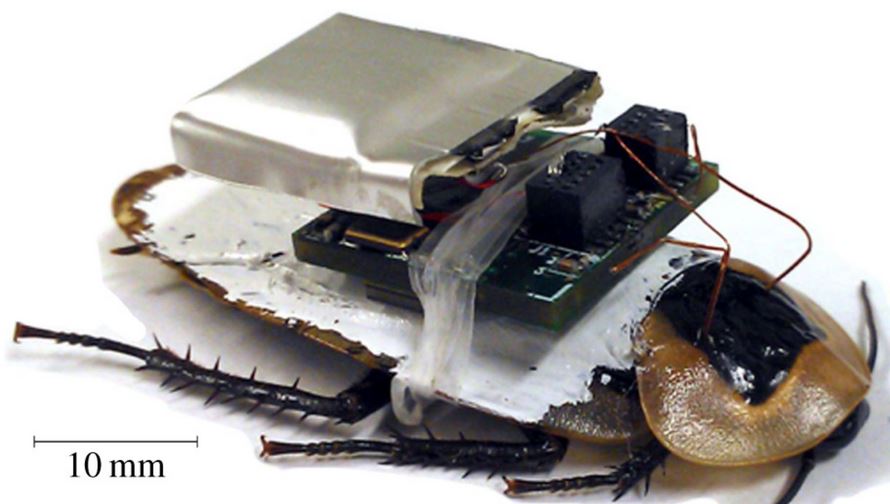If you think a cockroach cyborg – that is a normal roach hooked up to a miniature computer that does whatever you want – is impossible, think again, because that is exactly what scientists at Texas A&M University are in the process of creating.
Researchers at the departments of Mechanical Engineering and Entomology fused three types of live cockroaches with a tiny computer that is hooked into their nervous system. By just pressing buttons, you can control the animals.
Their study has been published in the Journal of the Royal Society Interface (citation below).
Study leader, Professor Hong Liang, said the robo-roaches would be useful in situations where it might be dangerous to use humans. With a mounted mini-camera they could enter broken sewers, collapsed buildings, or even war-zones to gather data.

A cockroach with an attached electronic backpack that has a battery on top and a board attached to the forewings. (Image: Interface)
In an interview with the Guardian newspaper, Prof. Liang said:
“Insects can do things a robot cannot. They can go into small places, sense the environment, and if there’s movement, from a predator say, they can escape much better than a system designed by a human. We wanted to find ways to work with them.”
Tiny backpacks stuck onto roach’s back
Prof. Liang and colleagues created miniature backpacks and stuck them onto the cockroaches with a special adhesive paint. Normal glue is no good for sticking things onto the insect’s waxy back.
The backpack contained a computer chip attached to fine wires that were connected to the cockroach’s leg nerves (one leg on each side). Including a rechargeable lithium battery, the whole backpack weighs less than 3 grams (0.01 oz).
The researchers were able to remotely stimulate the insect’s leg nerves and steer it. When a cockroach walks, its three legs on each side of the body move in a synchronized rhythm. By applying electrical impulses, the scientists were able to disrupt their limb movements by stimulating the middle leg to move out of step with the others.
Put simply, the scientists were able to remotely make the cockroaches turn left or right by pressing buttons that made one leg move out of synch.
The researchers say further studies are needed to improve the technology. At the moment, the insects can be steered about 70% of the time when they are connected with little leashes, and 60% of the time wirelessly.
Royal Society Video – Hybrid cockroach robots
Regarding cockroaches, Prof. Liang said:
“When I first saw them, my hair stood up. But I went on to keep some in my office as pets for a while. They are actually beautiful creatures. They are constantly cleaning themselves.”
Cockroaches get tired too
There is only so much weight cockroaches can carry on their backpacks. The research team carried out endurance tests by having the insects walk on a treadmill, and found that they tired sooner with heavier backpacks.
Prof. Liang and colleagues now want to see whether they can control more than just one leg on each side. If they can gain access to the nerves of all six legs, they might get them to run, walk, sit, stop and start on command.
Citation: “Locomotion control of hybrid cockroach robots,” Carlos J. Sanchez , Chen-Wei Chiu , Yan Zhou , Jorge M. González , S. Bradleigh Vinson and Hong Liang. Royal Society Interface. Published 4 March, 2015. DOI: 10.1098/rsif.2014.1363.
Guardian Tech Video – Cockroach robots
